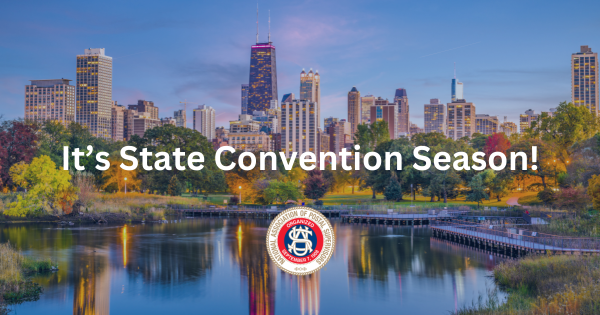It's State Convention Season!
It’s State Convention Season!
By Brian J. Wagner
Past NAPS President
April traditionally is the start of NAPS’ state convention season. What better time to start sharpening your tools—not the gardening kind, but a pencil? What better time to put your cap on—not work cap, but thinking cap? What better time to start digging—not into the soil, but into your state constitution and bylaws to review for any necessary changes?
And what better time to plant seeds in the form of state convention resolutions to change the way your branch conducts official NAPS business? What better time to attend and participate in your respective state convention to not only make your branch stronger, but NAPS, as well, at the local and national levels. Here’s the scoop.
If your local branch is a member of your state branch, it is important and incumbent on every local branch member to become familiar with their state constitution and bylaws. Understand how the state conducts business and spends state per-capita dues on behalf of its members.
At state conventions, local branches and their credentialed delegates can effect change by updating its state constitution and bylaws. Delegates also can give state officers instructions as to how members want the state to conduct business in accordance with its constitution and bylaws.
Members also can effect change by submitting convention resolutions. Those resolutions may be constitution-and-bylaws-based or a general resolution that instructs the state how it should conduct business on behalf of the membership.
However, just submitting a convention resolution will not effect change, unless the resolution is passed during state convention business.
When writing a state convention resolution, consider the helpful hints below. These are from a previous Postal Supervisor article, “Resolution Writing 101,” that our NAPS editor, Karen Young, puts in our magazine every national convention year.
- Resolutions always should request a certain action, never demand or threaten it.
- A “resolved” (or “resolves”) should be a complete, stand-alone statement that clearly and completely states the issue.
- Avoid using complex “resolves” that request unrelated actions. Stick to the issue at hand; don’t add a resolve that is not relevant to the resolution. It is like Congress adding something to a bill that has nothing to do with the intent of the bill, but to get another issue passed as a “tag-along.”
- Resolutions should request actions over which the named persons, groups or organizations have control.
- Don’t use fancy words when simple ones will do (say “use” instead of “utilize,” for example). And don’t use long, complex or run-on sentences. The beauty of “whereases” is they encourage a listing of simple reasons why an action should be taken. Break those long sentences into several shorter “whereases.
- Spell out the first reference, like DCO, which is “dues check off,” that might not readily be known to the reader. If the reader doesn’t instantly know what you’re talking about, you could lose support for your resolu tion. It’s perfectly okay to refer to an acronym, such as DCO, in second and subsequent references.
After resolutions are submitted, there will be floor discussions, which may be heated at times. Don’t make the discussion personal or take it personally. It’s business—NAPS business—with the intent of making our organization stronger and better by getting everyone involved in discussing and sharing ideas.
Enjoy your time and experience if you are attending a NAPS state convention this year, especially if it will be your first time attending. As a first-timer, take it all in and enjoy the ride, even if it gets a little bumpy. At the end of the convention ride, you will be a much-better informed and experienced NAPS member waiting for the next state convention season to hurry up and come.
My resolution is to hurry up and give my ice-cream-flavor-of-the-month-recommendation: cherry cheesecake.
